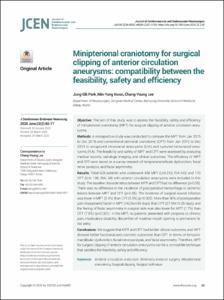KUMEL Repository
1. Journal Papers (연구논문)
1. School of Medicine (의과대학)
Dept. of Neurosurgery (신경외과학)
Minipterional craniotomy for surgical clipping of anterior circulation aneurysms: compatibility between the feasibility, safety and efficiency
- Keimyung Author(s)
- Lee, Chang Young
- Department
- Dept. of Neurosurgery (신경외과학)
- Journal Title
- Journal of Cerebrovascular and Endovascular Neurosurgery
- Issued Date
- 2020
- Volume
- 22
- Issue
- 2
- Keyword
- Anterior circulation aneurysm; Minimally invasive surgery; Minipterional craniotomy; Surgical clipping; Surgical technique
- Abstract
- Objective:
The aim of this study was to assess the feasibility, safety and efficiency of minipterional craniotomy (MPT) for surgical clipping of anterior circulation aneurysms.
Methods:
A retrospective study was conducted to compare the MPT from Jan 2015 to Dec 2018 and conventional pterional craniotomy (CPT) from Jan 2012 to Dec 2013 in unruptured intracranial aneurysms (UIA) and ruptured intracranial aneurysms (RIA). The feasibility and safety of MPT and CPT were assessed by analyzing medical records, radiologic imaging, and clinical outcomes. The efficiency of MPT and CPT were based on a survey research of temporomandibular dysfunction, facial nerve paralysis, and facial asymmetry.
Results:
Total 628 patients who underwent 458 MPT (UIA:313, RIA:145) and 170 CPT (UIA: 106, RIA: 64) with anterior circulation aneurysms were included in this study. The baseline characteristics between MPT and CPT had no difference (p>0.05). There was no difference in the incidence of postoperative hemorrhage or ischemic lesions between MPT and CPT (p>0.05). The incidence of surgical wound infection was lower in MPT (0.4%) than CPT (3.5%) (p=0.002). More than 90% of postoperative pain disappeared faster in MPT (14.25±4.83 days) than CPT (27.59±10.35 days), and the feeling of facial asymmetry in surgical side was also lower for MPT (1.7%) than CPT (7.6%) (p<0.001). In the MPT, no patients presented with progress to chronic pain, masticatory disability, discomfort of maximal mouth opening or permanent facial palsy.
Conclusions:
We suggest that MPT and CPT had similar clinical outcomes, and MPT showed better functional and cosmetic outcomes than CPT in terms of temporomandibular dysfunction, facial nerve paralysis, and facial asymmetry. Therefore, MPT for surgical clipping of anterior circulation aneurysms can be a compatible technique that satisfies the feasibility, safety and efficiency.
- Keimyung Author(s)(Kor)
- 이창영
- Publisher
- School of Medicine (의과대학)
- Citation
- Jung-Sik Park et al. (2020). Minipterional craniotomy for surgical clipping of anterior circulation aneurysms: compatibility between the feasibility, safety and efficiency. Journal of Cerebrovascular and Endovascular Neurosurgery, 22(2), 65–77. doi: 10.7461/jcen.2020.22.2.65
- Type
- Article
- ISSN
- 2287-3139
- Source
- http://www.the-jcen.org/archive/index.html?gubun=4&no=838&year=2020&vol=22&ho=2&page=65&ifv=1
- Appears in Collections:
- 1. School of Medicine (의과대학) > Dept. of Neurosurgery (신경외과학)
- 파일 목록
-
-
Download
 oak-2020-0083.pdf
기타 데이터 / 3.09 MB / Adobe PDF
oak-2020-0083.pdf
기타 데이터 / 3.09 MB / Adobe PDF
-
Items in Repository are protected by copyright, with all rights reserved, unless otherwise indicated.